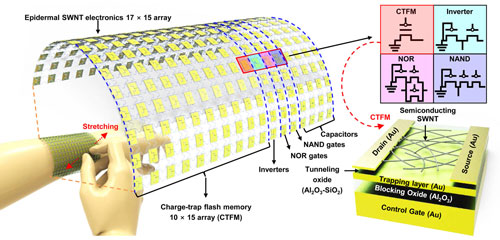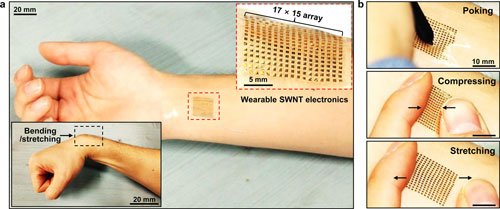| Posted: May 13, 2015 | |
Wearing single-walled carbon nanotube electronics on your skin |
|
| (Nanowerk Spotlight) Wearable electronic systems that are integrated into our clothing, work tools or even skin patches are around the corner. In developing these flexible electronics, one of the problems that researchers have to deal with has been the use of inorganic semiconductor layers (such as silicon or gallium nitride) for the active channels and dielectric: these materials are brittle and may may easily get damaged with repetitive bending. | |
| "Extensive research has been conducted to dissipate the induced strain in the channel and active regions, such as ultrathin thickness design approaches, neutral mechanical plane layouts, and stretchable interconnections," Ja Hoon Koo, a PhD student in Professor Dae-Hyeong Kim's Translational Flextronics Group at Seoul National University, tells Nanowerk. "More fundamental changes have been proposed to replace channel materials with soft ones, including graphene and carbon nanotubes." | |
| Compared to inorganic semiconductors, it is challenging to fabricate high density electronics using organic semiconductors that show uniform and stable performances over a large area. Developing stretchability into such system is another hurdle. | |
| Koo is one of the authors of a new paper in ACS Nano ("Stretchable Carbon Nanotube Charge-Trap Floating-Gate Memory and Logic Devices for Wearable Electronics") where the group reports stretchable single-walled carbon nanotube (SWCNT) based electronic devices, such as capacitors, transistors, nonvolatile memory units, and logic gates. | |
 |
|
| Schematic illustration of the SWCNT-based electronic devices as a wearable array platform, which consists of memory units, capacitors, and logic circuits (left). Simple circuitry schematics (CTFM, inverter, and NAND/NOR gates) are shown in the top right colored sections. The bottom right frame shows the cross-sectional layer information on the CTFM. (Reprinted with permission by American Chemical Society) (click on image to enlarge) | |
| In their article, the team presents materials and device design/fabrication strategies for an array of highly stable and uniform SWCNT-based stretchable electronic devices consisting of capacitors, charge-trap floating-gate memory units, and logic gates (inverters and NAND/NOR gates). | |
| The researchers' detailed material, electrical, and mechanical characterizations and theoretical analysis in mechanics provide useful insights in the design and development of SWCNT-based wearable electronic systems. | |
| The entire device is less than 3 µm thick and stretchable enough to enable conformal integration of electronics onto the human skin – electronic skin. | |
 |
|
| (a) Optical camera image of the array of SWCNT electronic devices (17x15) composed of CTFMs, inverters, NAND/ NOR gates, and capacitors. Conformal contacts are well made with a human skin. The insets show a magnified image (top right) and bending/stretching deformations (bottom left). (b) Deformed wearable SWCNT devices under poking (top), compression (middle), and stretching (bottom). (Reprinted with permission by American Chemical Society) (click on image to enlarge) | |
| Performing fatigue test on their memory and logic devices, the team found that even after stretching for 1000 times with ∼20% applied strain, the device performance shows minimal changes. | |
| "We are planning further investigations on the alignment of the CNT network using a solution process for improved performance – i.e. carrier density, mobility – and interchangeable polarity of the CNTs without a doping process," Koo outlines the team's next steps. | |
 By
Michael
Berger
– Michael is author of three books by the Royal Society of Chemistry:
Nano-Society: Pushing the Boundaries of Technology,
Nanotechnology: The Future is Tiny, and
Nanoengineering: The Skills and Tools Making Technology Invisible
Copyright ©
Nanowerk LLC
By
Michael
Berger
– Michael is author of three books by the Royal Society of Chemistry:
Nano-Society: Pushing the Boundaries of Technology,
Nanotechnology: The Future is Tiny, and
Nanoengineering: The Skills and Tools Making Technology Invisible
Copyright ©
Nanowerk LLC
|
|
|
Become a Spotlight guest author! Join our large and growing group of guest contributors. Have you just published a scientific paper or have other exciting developments to share with the nanotechnology community? Here is how to publish on nanowerk.com. |
|
